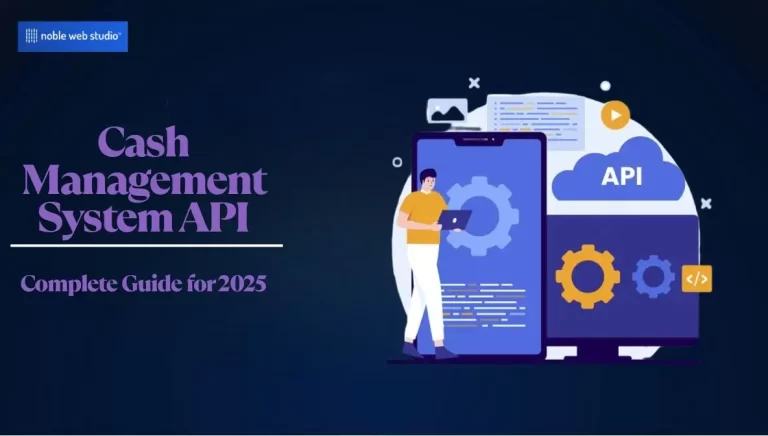A Cash Management System (CMS) API lets businesses access and control their cash flow information through a software interface. This helps them watch cash balances, transactions, and available funds in real time. It also allows automatic tasks like matching accounts, making payments, and predicting cash needs. APIs can connect to other systems such as ERPs and bank websites to make data sharing easier and faster.
In this simple and easy guide by NobleWebStudio, we will explain everything you need to know about Cash Management System (CMS) APIs. You’ll learn about their main features, benefits, and how businesses use them in real life. This will help you understand how to improve and manage your cash flow better in 2025.
What is a Cash Management System API?
A Cash Management System (CMS) API, also known as a Cash Management System Application Programming Interface, is a software interface that enables different systems and applications related to cash management to exchange information and interact. It functions as a connector, allowing smooth integration among various parts of a company’s cash management operations.
Here’s a more detailed explanation:
What it is:
An API is a collection of rules and guidelines that enables various software applications to interact and share data. In the area of cash management, it supports the transfer of information and the performance of tasks related to cash flow, payments, and other financial activities.
Examples:
Companies can leverage CMS APIs to:
Automate the reconciliation between bank statements and accounting records.
Initiate payments directly from their accounting software to their bank.
Track cash positions instantly across several banks.
Incorporate cash flow forecasting into their financial planning efforts.
Types of APIs:
- Private/Internal APIs: Used within the company or with partners inside the same organization.
- Public APIs: Available to outside developers and apps, often used for open banking services.
- Partner APIs: Give trusted third-party partners access to certain data or features.
How Does a Cash Management System API Work?
A Cash Management System (CMS) API works as a software interface that lets different systems and applications involved in cash management communicate and share data. It enables businesses to connect their own systems with a CMS, providing real-time access to cash management information, automating tasks, and making operations more efficient.
When a company utilizes a CMS API, it can link its accounting software, treasury management systems, banking platforms, and other associated systems. This connection enables real-time data sharing, task automation, and more efficient processes.
How it works:
Real-time data access:
APIs provide real-time cash information, helping businesses forecast cash better and make smarter decisions.
Automation:
APIs can automate tasks like payments, collections, and reconciliation, cutting down on manual work and mistakes.
Integration:
APIs allow easy connection with other systems like ERP (Enterprise Resource Planning) and treasury management software.
Enhanced efficiency:
By automating work and giving real-time data, APIs make cash management processes faster and more efficient.
Improved financial performance:
Having better control and visibility over cash flow through APIs can help businesses improve their financial health.
Cash Management System API Work
CMS API is a software tool that helps different systems and applications involved in cash management talk to each other.
It allows businesses to connect their own systems with an external cash management system, like PaySprint’s CMS API.By using our CMS API, businesses can check real-time cash management data, automate their cash-related tasks, and make their daily work smoother.
Cash Management System APIs can also be customized as per the unique needs of different businesses, whether big or small, and from any industry.
They can be accessed through web platforms, mobile applications, and direct API connections.
Read Blog : What is AEPS Cash Deposit API? Complete Guide
Why Should Your Business Use a Cash Management System API?
A Cash Management System (CMS) API helps businesses connect their systems with a third-party cash management platform. It gives them real-time access to cash data, automates daily tasks, and makes their work smoother and faster. By using a CMS API, businesses can manage their cash better, boost financial control, and cut down on time spent on manual work.
How Businesses Can Use a CMS API:
Better Cash Management:
A CMS API helps businesses see their cash positions in real-time, so they can make quick and smart decisions to manage their cash flow better.
Boost Financial Health:
By automating daily tasks and reducing mistakes, these APIs help improve financial performance and make operations more efficient.
Automate Everyday Tasks:
Things like payment processing, reconciliations, and reports can be handled automatically through APIs, saving time and effort.
Get Real-Time Cash Data:
Businesses can instantly view their cash balances, transactions, and available funds, helping them respond faster when needed.
Simplify Cash Management Work:
APIs cut down on manual work, combine data from different places, and make cash management smoother.
Reduce Manual Work:
Since tasks are automated and data is updated in real-time, businesses spend less time on manual processes and avoid errors.
Combine All Data in One Place:
APIs connect with multiple bank accounts and systems, bringing all financial data together in one easy-to-access platform.
Automate Data Handling:
There’s no need to log in to different bank websites. APIs automatically collect and manage cash data for you.
Enable Instant Payments:
With APIs, businesses can send payments immediately, helping them stay on top of urgent transactions.
Connect with ERP Systems:
APIs easily work with business software like ERP systems, making it simple to move and manage financial data.
Access to Same-Day Liquidity Tools:
APIs offer services like intraday liquidity management, helping businesses use their cash smartly throughout the day.
Monitor Account Activity:
Businesses can track money coming in and going out of their accounts in real-time, giving them a clear view of their cash at all times.
Key Features of a Cash Management System API
The power of a CMS API lies in its ability to automate and optimize multiple aspects of cash management, helping businesses improve their financial efficiency. Below are the core features and benefits businesses can expect when using a CMS API:
1. Real-time Data Access
One of the most significant advantages of a CMS API is real-time data access. APIs provide businesses with instant updates on account balances, transactions, and other vital cash management information. This eliminates the need for manual data collection and batch reporting, allowing businesses to make more informed decisions quickly and accurately.
Benefit: Real-time data access ensures that businesses are always up to date with their cash position, enabling faster decision-making and reducing the risk of cash shortages or over-extensions.
2. Automation
A CMS API automates repetitive and time-consuming tasks such as cash collections, payments, and reconciliations. Automation not only reduces the chances of human error but also enhances overall efficiency by freeing up time for other strategic activities.
Benefit: Automation leads to cost savings, better resource utilization, and increased operational efficiency. Businesses can focus on growth while leaving routine tasks to the system.
3. Improved Cash Flow Forecasting
With real-time data and automated processes, businesses can achieve more accurate cash flow forecasting. A CMS API allows for the collection and analysis of past and current transaction data, helping businesses predict future liquidity needs.
Benefit: Better forecasting ensures that businesses have the necessary liquidity to meet obligations and make investments. This reduces the risk of cash flow disruptions and improves financial planning.
4. Enhanced Visibility
The CMS API offers businesses a comprehensive view of their cash position across multiple accounts and banks. This visibility allows businesses to track their liquidity levels and ensure that funds are allocated appropriately.
Benefit: Enhanced visibility provides businesses with a clearer understanding of their financial situation, helping them manage their cash more effectively and make strategic decisions regarding investments and financing.
5. Seamless Integration
A CMS API can be easily integrated with other business systems, such as ERP, treasury, and finance applications. This seamless integration ensures that businesses can manage their cash flow within their existing infrastructure without having to adopt entirely new systems.
Benefit: Integration with other systems streamlines processes, reduces manual entry errors, and ensures that financial data is consistent across all platforms.
6. Cost Savings
By automating manual processes and improving efficiency, a CMS API helps businesses save on operational costs. Furthermore, automation reduces the need for additional staff to handle cash management, allowing businesses to reallocate resources to other areas.
Benefit: The reduction in costs allows businesses to improve their profit margins and reinvest savings into growth initiatives.
7. Strategic Advantage
A CMS API empowers businesses with real-time data, enabling treasury teams to make more strategic decisions. This includes optimizing cash placement, financing decisions, and managing risk effectively. Real-time insights allow for better cash management and ensure that businesses are well-prepared for financial challenges.
Benefit: The ability to make strategic financial decisions improves a business’s agility and financial resilience, positioning it for long-term success.
Read Blog : What is Domestic Money Transfer in India? A Complete Guide
Key Benefits of Using a Cash Management System API
A Cash Management System (CMS) API offers many benefits, mainly focused on automation, real-time data access, and better cash flow management. These advantages include automating tasks, providing real-time data visibility, improving security, saving costs, and helping businesses make more informed, data-driven decisions.
Here’s a closer look at the benefits of CMS APIs:
Automation:
CMS APIs can automate key cash management tasks, such as payments, collections, and reconciliations. This reduces the need for manual work and minimizes the chances of errors.
Real-time Data Access:
Businesses get access to real-time data on their cash position and transactions, allowing for quicker decision-making and better cash flow forecasting.
Improved Efficiency:
With automation and real-time data, businesses can streamline their processes, making cash flow management more efficient.
Cost Savings:
By automating tasks and boosting efficiency, CMS APIs help lower operational costs, freeing up resources for more important strategic initiatives.
Enhanced Security:
CMS APIs often have strong security features, including authentication and encryption, to keep financial data safe.
Data-Driven Decisions:
The insights and real-time data from CMS APIs help businesses make smarter decisions about investments, managing cash flow, and reducing risks.
Improved Liquidity Management:
CMS APIs allow businesses to better manage their liquidity, ensuring they have enough cash available when needed and optimizing working capital.
Simplified Compliance:
Automated reporting and record-keeping through CMS APIs make compliance easier and reduce the workload, improving corporate governance.
Enhanced Transparency:
These APIs offer a central platform for tracking and managing cash flow, promoting greater transparency and accountability across the business.
Increased Speed and Flexibility:
CMS APIs allow businesses to onboard and integrate quickly, enabling them to adapt to changing needs and take advantage of new technology.
How to Implement a Cash Management System API?
A Cash Management System (CMS) API helps businesses manage and automate their cash flow processes securely. It offers features such as real-time cash tracking, the ability to start payments, and automating reconciliations. The API allows other applications to connect with the CMS, giving access to important information like cash positions, transaction details, and liquidity.
Identify Requirements:
Begin by clearly understanding the specific needs of your Cash Management System (CMS) API. Define the core features and functionalities required to optimize cash flow management, such as real-time transaction monitoring, payment automation, and integration with other financial systems.
Choose the Right API Technology:
Selecting the right API technology is crucial for your CMS. Consider using REST (Representational State Transfer) or SOAP (Simple Object Access Protocol) depending on your application’s scalability, flexibility, and security needs. REST APIs are widely preferred for their simplicity and speed, while SOAP is ideal for businesses requiring robust security features.
Design API Endpoints:
Carefully design the API endpoints, as these will be the interface through which other systems interact with your CMS. Define the endpoints clearly, specifying their functionality, supported data formats (like JSON or XML), and request/response structures. This ensures that your CMS API integrates smoothly with third-party systems and external applications.
Develop Backend Logic:
The backend logic is the heart of your CMS API. Implement the core logic that processes incoming API requests, interacts with your databases, and efficiently handles cash flow transactions. Ensure that the system can process data in real-time, minimizing transaction delays and errors.
Implement Robust Security Measures:
Given the sensitivity of financial data, implementing strong security measures is essential. Utilize authentication protocols like OAuth for secure access, encryption methods like TLS for data protection, and authorization layers to restrict access to sensitive financial information. These measures will ensure the integrity and confidentiality of the data.
Test the API Thoroughly:
Before launching, conduct extensive testing to ensure your CMS API operates as intended. Test for performance, security vulnerabilities, and functionality under high loads. Consider using automated testing tools to simulate real-world usage and ensure your API can handle all potential scenarios.
Create Comprehensive API Documentation:
Develop clear and detailed API documentation for both developers and end-users. This documentation should include how to authenticate, use the API endpoints, data structures, and error codes. Well-documented APIs make integration and usage easier for clients and third-party developers.
Deploy and Monitor the API:
Once testing and documentation are complete, deploy the CMS API and monitor its performance continuously. Track metrics such as response times, error rates, and usage statistics to ensure optimal operation. Use monitoring tools to detect issues early and ensure smooth, uninterrupted service for users.
Read Blog : How Does a Payment Gateway Work? Everything You Need to Know
Examples of API Usage in Cash Management
In today’s fast-paced digital finance landscape, Cash Management System (CMS) APIs play a vital role in streamlining and automating financial processes. Here are some of the most common and impactful ways businesses use APIs in cash management:
- Automated Payment Processing
APIs enable businesses to automatically create and submit payments to vendors, reducing manual errors and saving valuable time. This not only improves operational efficiency but also ensures faster, secure, and more accurate payment processing. - Real-Time Reconciliation
With API integration, businesses can instantly reconcile bank statements with their internal accounting systems. This automated process ensures data accuracy, helps identify discrepancies in real-time, and minimizes the risk of financial errors. - Intraday Cash Forecasting
CMS APIs deliver live data on cash inflows and outflows throughout the day, making intraday cash forecasting more precise. This gives treasury teams better control over cash positions, liquidity planning, and fund allocation decisions. - Integration with ERP Systems
APIs seamlessly connect your Cash Management System with Enterprise Resource Planning (ERP) software. This integration allows for the automatic transfer of payment details, transaction data, and financial reports, ensuring a unified and efficient financial workflow.
In summary, a Cash Management System API offers a smart, efficient, and real-time solution to automate cash management operations, enhancing accuracy, financial decision-making, and overall business performance.
How to Choose the Right CMS API for Your Business
For businesses, having a reliable and adaptable headless CMS with a strong API is essential for managing and delivering content across different channels. Some platforms that stand out in this area include Contentful, Strapi, Sanity, and Agility CMS. These platforms focus on an API-first approach, making it easy to integrate with different technologies and front-end frameworks.
When choosing a CMS API, there are several key factors to consider:
Scalability and Reliability: A reliable CMS API is essential to handle large amounts of content and traffic without compromising performance.
API Flexibility: It is important that the API can support different standards, such as REST and GraphQL, and allows for customization of content structures to work with various front-end technologies.
Developer Ecosystem: A strong community and accessible documentation can greatly enhance the development process, making it easier for developers to work with the CMS API.
Integration Capabilities: The CMS API should integrate smoothly with existing systems, such as marketing platforms, e-commerce solutions, and CRM tools, to ensure a seamless workflow.
Content Modeling: The ability to define complex content structures and relationships is crucial for managing a variety of content types, ensuring the CMS meets your business needs.
Content Delivery: The API should be able to efficiently deliver content to multiple channels, such as websites, mobile apps, and IoT devices.
Headless CMS Platforms with Strong APIs:
- Contentful: Known for its scalability and reliability, making it a great choice for larger businesses with complex content needs.
- Strapi: This open-source CMS offers high flexibility and control through its customizable API, making it a popular choice for developers.
- Sanity: A leading API-first CMS, designed to offer a developer-friendly experience while providing powerful API capabilities.
- Agility CMS: Focuses on a content-first approach with a strong REST API, making integration with various systems straightforward.
Top Trends in Cash Management System APIs for 2025
Several important trends are shaping the future of cash management systems, especially with the growth of APIs. These trends include real-time access to data through API connections, the use of AI and machine learning to improve forecasting and decision-making, and the rise of open banking and payment hubs, which are helping to make transactions more efficient and secure.
Real-time Data Access through API-driven Connectivity:
- Description: Banks and financial institutions are using APIs to provide businesses with real-time access to important data, such as account balances, transaction details, and payment statuses.
- Benefits: This allows businesses to integrate banking data directly into their systems, improving cash management, making forecasting more accurate, and speeding up decision-making.
- Examples: Some API-driven solutions include real-time push payments, instant reporting of balances and transactions, and more efficient liquidity consolidation.
AI and Machine Learning for Enhanced Forecasting and Decision-Making:
- Description: AI and machine learning algorithms analyze both historical and real-time data to forecast future cash flows and support decisions in areas like cash forecasting, liquidity management, and risk reduction.
- Benefits: AI can make more precise predictions, automate routine tasks, and detect patterns that might be overlooked by manual analysis.
- Examples: Tools that use AI for forecasting, intelligent systems for automated decision-making, and AI-powered fraud detection mechanisms are some common examples.
Open Banking and Payment Hubs:
- Description: Open banking, powered by APIs, allows businesses to connect with various banks and payment platforms, offering a more seamless and integrated experience.
- Benefits: This leads to improved operational efficiency, lower costs, and better security, as seen in platforms like Cash Flow Frog.
- Examples: Examples include payment hubs that centralize payment processing, account aggregation through APIs for unified login experiences, and real-time payments that allow instant fund transfers.
Read Blog : Micro-ATMs: The Ultimate Solution for Seamless Banking Transactions
Why Choose NobleWebStudio for CMS API Integration?
As businesses continue to embrace digital transformation, Cash Management System APIs will play an increasingly critical role in optimizing cash flow management. By offering real-time access to financial data, automating key processes, and providing enhanced visibility, CMS APIs empower businesses to make smarter financial decisions.
Partnering with a reliable CMS API provider, such as NobleWebStudio, ensures that your business can streamline its cash management, reduce operational costs, and gain a competitive edge in the market. By leveraging the power of automation and real-time data, your business can improve its liquidity forecasting, minimize financial risks, and achieve long-term financial success.
In 2025 and beyond, embracing a CMS API is more than just a smart move it’s a strategic necessity for businesses seeking to thrive in the modern financial landscape.
Conclusion
In 2025, businesses need to adopt innovative solutions like a Cash Management System (CMS) API to stay competitive in an increasingly digital and automated world. A CMS API offers numerous benefits, including real-time data access, automation, enhanced visibility, and better decision-making capabilities.
By leveraging the power of a CMS API, businesses can improve cash reconciliation, optimize liquidity management, and streamline their financial processes. Partnering with a trusted provider like NobleWebStudio ensures you are equipped with the best tools to succeed.
Integrating a CMS API will enable businesses to manage their cash flows more efficiently, save time and costs, and make informed, strategic financial decisions that drive growth and success.
FAQs About Cash Management System API
Ans. The main benefit is enhanced visibility of cash flows, enabling businesses to manage payments, cash positions, and forecasts in real-time, thus making informed decisions and improving overall financial management.
Ans. A CMS API automates payment processing by allowing businesses to initiate transactions instantly, ensuring they are completed without delays. It also integrates securely with banking systems to minimize errors and risks.
Ans. Yes, CMS APIs are designed to integrate with existing ERP and accounting systems, allowing businesses to streamline workflows and automate cash management tasks efficiently.
Ans. Yes, CMS APIs feature high-level security protocols, including encrypted communication and pre-validation of payment details, to prevent fraud and ensure secure transactions.
Ans. To get started with a CMS API, businesses need to contact a reliable API provider like NobleWebStudio. Our expert team will assist with the integration process, ensuring a seamless setup and optimal performance.




